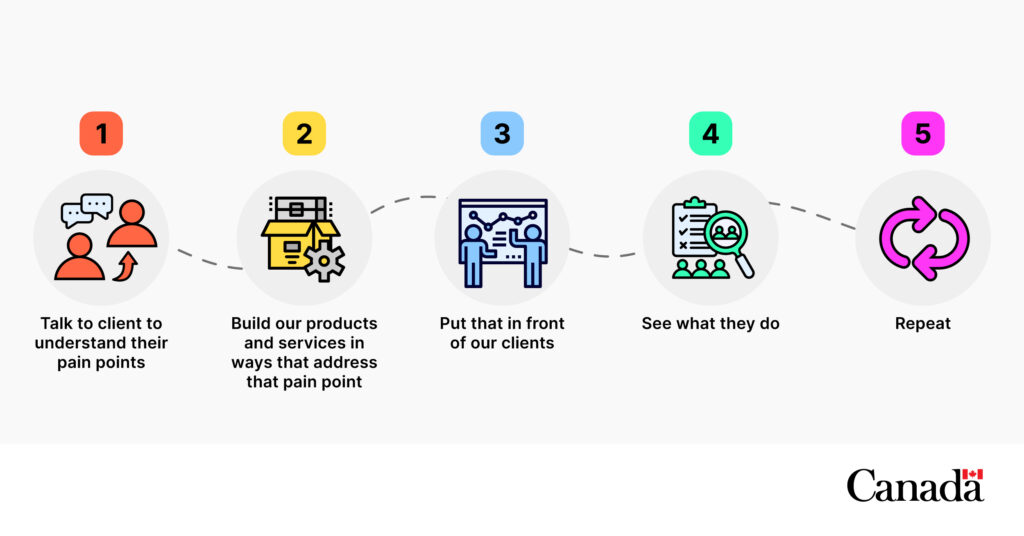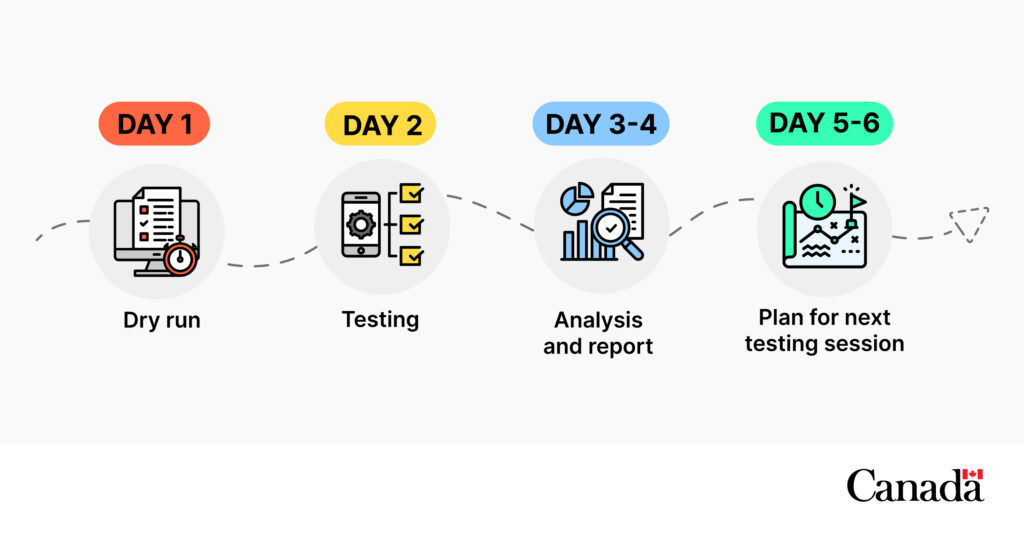
Did you know that until recently, one in three people in Canada lacked dental insurance and one in four reported skipping dental visits due to cost? To address this problem, the Government of Canada introduced the Canadian Dental Care Plan in April 2023. To make sure people could easily apply for the plan and understand the process, the Client Experience Office (CXO) at Service Canada worked with teams across government and validated with the public to determine the best way to make that happen.
Keep reading to see how the CXO used their expertise in client experience research (how individuals interact with a service from start to finish) to ensure people’s needs, preferences, and experiences were at the forefront of the service design process for the Canadian Dental Care Plan and designed a solution that was simple, efficient, and accessible.
What is the Client Experience Office (CXO)?
The CXO is part of a bigger movement to change how government works. The team is made up of service designers and UX researchers that believe in testing services with real users and using their feedback to make it easier to get the benefits they are entitled to.
The Canadian Dental Care Plan
The Canadian Dental Care Plan (CDCP) is a program designed to help cover 9 million previously uninsured Canadian residents by 2025. The CDCP is the largest federal government benefit program in the last 60 years, covering 23% of the population.
Service Canada was tasked with helping design access points to this service. The Government of Canada announced that it would begin accepting applications in December 2023, and the Department mobilized quickly to ensure early and effective access to the program for Canadians. Stakeholders within Service Canada and partners in many departments have since been working collaboratively to make this a success.
The challenge: Design and launch the program in record time (eight months), with a focus on seniors aged 65 and older.
The CXO knew that seniors generally avoid self-serve options, preferring ‘high-touch’ service channels. This means that they appreciate services where there is a high level of personal contact between themselves and the organization providing the service, like call centres or In-Person services.
The team knew that millions of individuals could be using this plan when it launches, so the service needed to be designed with as few touch points as possible while adhering to policy restraints and budget.
Faced with an aggressive timeline and diverse stakeholders’ priorities, the CX team worked to ensure that users’ needs, preferences, and experiences were at the forefront of the service design process.
The approach
To reach this goal, the project team led by Integrated Service Strategy and Operations (ISSO) connected the CXO with policymakers and stakeholders across multiple federal departments, to brainstorm the best approach.
Based on the CXO team’s research on seniors and best practices, the team knew that the application:
- Needed to be easy to understand
- Could not be exclusively online
- Should leverage the channel preference(s) of this population
- Required minimal effort to complete
Visual artefacts, such as client flows and service blueprints, were invaluable in creating and implementing the CDCP as they helped map the client journey, which enabled the team to visualize the entire process. They helped identify potential barriers, which allowed stakeholders to align on key challenges. The artefacts helped to facilitate discussions among multidisciplinary teams, which in part led to the production of the user-centric solutions that were deployed.
The proposed solution: Interactive voice response (IVR). IVR is an automated phone technology that allows clients to access and provide information through voice or menu inputs without having to speak to a live agent.
The revised service model, dubbed the “streamlined approach”, involved:
- Identifying potentially eligible seniors using data provided by the Canada Revenue Agency.
- Sending letters informing them of their potential eligibility.
- Inviting them to apply by calling the CDCP Contact Centre (where the IVR would be ready to help them).
- Encouraging self-service using the information in the letter and personal identification.
When applying, the IVR asked seniors for their social insurance number, the code included in the letter, and if they had access to private dental benefits. They were immediately notified whether they had been successful in applying and whether they qualified for the plan.
The testing phase
There are a lot of steps between the idea and the outcome. One of the most crucial steps is usability testing. The Government of Canada Digital Standards outlines the importance of researching with users to understand their needs that will guide design and development. By including users from the start, you build a more user-centric, intuitive, and easy-to-use service that is consistent with user needs and experiences.
The CXO takes this to heart. To do just that, they went to the source; Service Canada Centres.
Testing with users at Service Canada Centres
To ensure that the letters and IVR systems were easy to understand and accessible to seniors, the CX team conducted targeted usability testing at physical Service Canada Centres (SCCs) where Canadians go to access a variety of federal government services and benefits in person. Engagements led to client-centered recommendations shared with stakeholders to inform ongoing service design iterations.
The usability testing team observed distinct behaviours in participants and created personas to represent their findings, explain design decisions, and improve the IVR content. Using a plain language approach, recorded messages were shortened, with an emphasis on action words (i.e., “check your application status” instead of “enquire about the status of your application”).

Alt-Text: 5 steps involved in usability testing; research client needs, build product, show clients, see what they do, and repeat.
More on our research method
Conducting iterative testing with users at Service Canada Centres allowed the team to take a novel approach that enabled them to understand client interactions with products and provide focused feedback to refine the design in real-time.

Alt-text: Timeline of usability testing session. Day 1 dry run, day 2 testing, days 3-4 analysis and report, and days 5-6 plan for next testing session.
The team conducted several rounds of testing in French and English for the invitation and correspondence letters and used a low-tech, cost-effective method to simulate the IVR phone system. Usability testing led to personalized, shortened, and simplified letters and more-concise language for the IVR.
Participants were given props including a paper printout of a phone pad and interacted with the system while a team member voice-acted recorded prompts and responded to button presses. This inexpensive and rapid prototyping approach facilitated iterative testing and refinement based on user feedback.
The impact of CX work
Following the implementation of the usability testing and the resulting recommendations made by CXO, the percentage of clients who successfully applied through the phone unassisted, nearly doubled those applying with the draft scripts. This ensured more resources were available to allow those who wanted to speak to an agent to have their calls answered within seconds. The work the CXO did removed pain points, reducing frustration and time spent applying, which meant individuals could easily complete the application. The goal was never to remove the high-touch service channels that some prefer, but to simply create a way for those who needed that option to get through quickly, while providing an efficient and simple option to those who are open to self-serve tools.
Tips for testing with users
User research, usability testing, and implementing findings is hard. Every project is different, and each has its own challenges. However, the CXO does have some advice/reflections on what they have learned during their work on CDCP so far:
- Co-designing with multiple departments and stakeholders requires building a trusting relationship and showing the return on investment (ROI) of a client experience that gives voice to clients. This can take time, but it’s worth it.
- Service blueprints and client flows are great tools for co-design and cross-collaboration because they help different teams work together better by providing a clear picture of challenges and opportunities. This shared understanding promotes joint problem-solving and creativity, resulting in a smoother, more client-focused service design.
- Usability testing can be done quickly and does not have to be expensive or complicated, which makes it a great tool for teams to use.
- Although many services are advancing to become more digital, usability testing has shown us that there are still many vulnerable clients with other channel preferences that we cannot leave behind. Delivering a digital-first service still requires additional measures to ensure it remains accessible.
- Integrating usability testing with people into product delivery is important. Doing so ensures we, as the Government of Canada, continue to transform how to design and deliver services. Be open to having your assumptions questioned, and allow testing and research to inform how policies, services, and products are designed for people’s needs and capabilities.
CXO: Looking forward
The CXO’s excellent work led to project teams and stakeholders actively requesting testing for the next phases of implementation: children, people with disabilities, and eventually, all Canadians.
Service blueprinting, client flows, and usability testing are now serving as a foundation for service delivery design of the upcoming Canada Disability Benefit for working age persons with disabilities. Find out if you qualify for the CDCP and apply today!